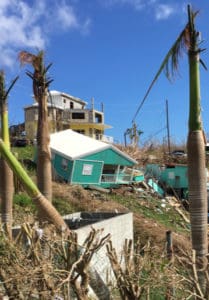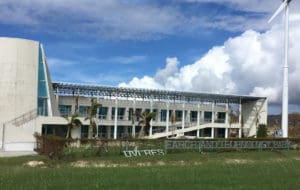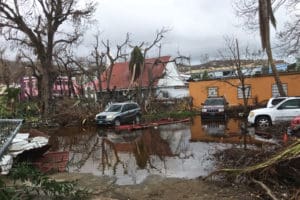
When two Category 5 hurricanes struck the Virgin Islands, 10 days apart, in 2017, they left a wealth of stories to be told. Stories from citizens and first responders. Veterans of disasters and those who had never seen anything like the destructive force of Hurricanes Irma and Maria before in their lives. Stories from when Hurricane Irma struck can be seen here.
Here are some of the stories from when Hurricane Maria hit.
Kevermay Douglas, deputy supervisor of Elections, St. Thomas
Hurricane Irma brought a utility pole down just above my stairs and so we contemplated that when Hurricane Maria came we would not stay home. Its because we feared the pole might fall and cause much destruction, or even kill us.
But my mom, due to her health issues, was comfortable at home with me and didn’t want to leave. So we decided to stay.
Based on the wind and what we were hearing outside, it caused more stress for me. I’m worried about my mom, since she was in the hospital the week before. But my mom was so strong in her faith that prayer and trust that the Lord would take care of us.

So she lay in the bed and never moved, while I could not stay still. I was worried; I was exhausted and moved from room to room – prayed and prayed. I was tired, my mouth was dry. But I kept pushing on and praying, and knowing that we still have a mighty God.
And so I believe the wind started to ease up about 4 in the morning. And when we were able to finally break through the door – we had sealed the door up tightly – we got outside.
And one of the first things we noticed was the pole that Irma brought down was pushed straight back in position as if WAPA had replanted the pole. And no one, friends or family that came to look for us, could believe it was Hurricane Maria that put it back up in its place.
I use that story as an inspiration and an encouragement for people, to believe that there is a God and we must continue to trust and believe in him because he is almighty.
Holland Redfield, broadcaster Isle 95, WJKC-FM, St. Croix
With my background in aviation, I have to understand weather more that the average person. The national weather bureau was off with reference to their projections. It created a conflict, because we have our own weather bureau that we work with, that generally is right on the mark.
We were using the European model, that tends to be more accurate. And we were predicting a direct hit.
We were obviously right on the mark.
The challenge is obviously having the responsibility we have is not to scare the public; more to prepare them. In other words, hope for the best, be prepared for the worst.
So as this was rolling in, my concern was whether the public was ready, and second of all, if the facility I was in could withstand winds in excess of 175 mph. And it proved that it could not.
So we were the only radio station in the Virgin Islands that was on at the height of the storm. We were actually simulcasting on six of our radio stations. As the storm progressed, we were dropping off each radio station and I was instructing my listeners to go to the next frequency until we finally went off at about 3 o’clock in the morning.

Our roof was taking on water and I had to leave the studio because I was concerned that I would electrocute myself and our engineers would be electrocuted.
I was carried out of the studio on the backs of police officers because I could not navigate my way through the debris. I live close to town, a trip that would normally take me 10 minutes. It took me an hour and a half, with police and the crew moving debris.
Telephone polls down, live wires and trees falling on the roadways.
In the morning we were back on the air about 9:30, 10 o’clock and the police commissioner led the way, stopped by my apartment and escorted me back to the station, where I continued informing the public.
At night – I’m a conservative individual and don’t believe in miracles or things out of the ordinary – but when I left the studio, there was an eerie glow in the studio adjacent to us. Every time I turned around to try and figure it out it disappeared. It made no sense to me.
But when the glow stopped, I got the hell out of the studio. Someone was sending a message: Find a tra-la-la out of the studio.
The storm itself, and being there that night, was obviously a challenge. However the recovery, to me, was my biggest challenge. Dealing with a community that had a sense of helplessness, and hopelessness, and anger.
So I felt that that period – as well as right now – combined with a political race for the governorship and the Senate has truly complicated the process. And in many cases, divided us.
And the finger pointing is tragic.
Kathy and Randy Tiddark
Kathy and Randy Tiddark have owned Caribbean Breeze Apartments on Prince Street in Frederiksted since 2014. Kathy tells their story.
During Hurricane Maria, the roof of their Prince Street neighbor flew off and came down into their entryway. It was a wooden and metal roof that was attached without any screws. There were no occupants at the time.
When the roof came down, if totaled our three cars. It was one giant piece of old mahogany that flipped over and landed on our cars.
On the other side of their yard, their old tamarind tree uprooted and slammed onto the corner of their Queen street neighbor’s roof.
I thought the tree could be saved and we would have spent the money to have the work done, but we saw after a few days that it was dying. We thought that straightening the tree would help. But there was no way to save it.
Working on the tamarind tree was our first priority after the hurricane. We had three different crane companies come to give us an idea of the work that they could do. They suggested cutting the flamboyant trees to get in and we didn’t want that. We’ve already lost two-thirds of our flamboyant trees.
A couple months after the storm, our neighbor went to the Department of Agriculture, the Department of Planning and Natural Resources and the University of the Virgin Islands. She was at a dead end and finally went to Historic Preservation. All of this research was to find someone to remove the tree.
There is no way a crane can come into out yard or our neighbor’s yard and remove the tamarind tree. It will remain as a reminder of Hurricane Maria.
Recently, workers were able to lasso the huge branches, climb up and chain saw them off the tree. We were able to salvage some pieces to use later, Tiddark said. One realy huge piece came down and hit the five-foot concrete wall. We can’t repair that wall until we know what we will eventually do with the tree.
We’re not concerned with the damage to our shed, because it’s just a shed and we can build a new one. We are concerned with getting that huge trunk off of our neighbor’s roof.
That tamarind tree remains as a reminder of Hurricane Maria.
Bruce Flamon, St. Thomas emergency shelter manager
Flamon, a former Chicago firefighter and longtime VI resident, began his story with an account of what happened two weeks earlier, during Hurricane Irma, while managing shelter operations at the E. Benjamin Oliver Elementary School. Irma’s winds tore the roof off of the primary shelter near the gym, then the school library after the occupants were relocated there. The chaos led to a decision to move everyone to Lockhart Elementary School in Sugar Estate, which is where Flamon picks up the story of Hurricane Maria.
I was the manager at the shelter. We had approximately 85 to 90 for the first storm. And then when Maria hit, we had over 150, 160 residents from Sea View (Nursing Home, Bovoni) to our shelter.
They moved all the people from the shelter downtown. That was the senior shelter down by Lionel Roberts (Stadium, Hospital Ground). Everyone to Lockhart Elementary. So we had 200 residents. It was really a sight and it was really difficult, managing with the Red Cross and with Human Services.
The one thing that I liked was that every resident that was homeless, every resident that was mentally ill, was in the shelter.
Kim Wesselhoft Lyons, former VIPD community liasion
I decided to stay with friends rather than stay alone. I was also close to the water and not sure of the house where I was renting. At that point, the track of the storm was right off Sandy Point. The east end of St. Croix fared much better in the storm in comparison to the west end.
The next day we drove west and that is when we saw the real damage. When we got to Williams Delight, Hanna’s Rest, Campo Rico area. That’s when we realized how bad it was. It looked terrible. Lots and lots of damage. One house after another with roofs ripped off. Big mahogany trees that looked like they had been pulled up from the roots.
It took over three hours to even get to my place because the roads were blocked by trees, lines and debris. My roof was OK, but the windows had all been breeched, so I had a lot of water inside. It took over a week to clean it all up. But several neighbors had lost their roofs.
I had more damage where I was building in the rainforest. It took a few days before I could even get up there. The Army Corps of Engineers had to cut the trees that had fallen across the road. Mahogany Road looked like a series of bombs had dropped from west to east. I had a 40-foot container on my property that ended up in a gut on someone else’s property.
It went through the air like Dorothy in the Wizard of Oz.
Sally Petty, deputy Joint Force commander, Virgin Islands National Guard
Most of the soldiers and airmen are younger, so these hurricanes were a new experience for them. They don’t recall the Hurricane Hugo or the Hurricane Marilyn and its aftermath. We responded for those too.
Many of their families were impacted, homes were severely damaged. Some were permanently displaced, but they came out, they responded. They went above and beyond for the disaster that took place and the Virgin Islands National Guard did the Virgin Islands great service.





